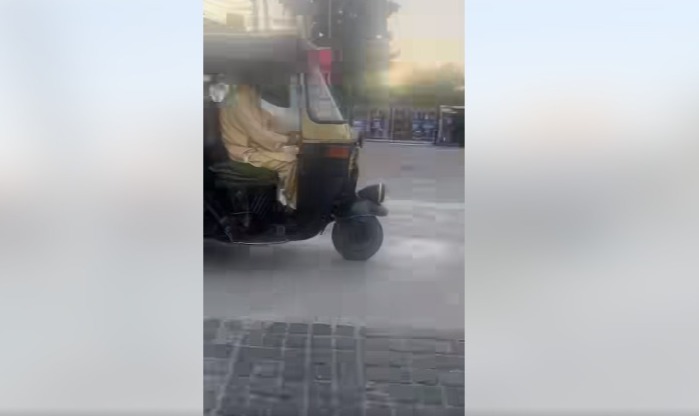
A recent video circulating in Kashmir has garnered significant attention, with over 100,000 views on Facebook alone. In this video, an unknown person, presumably from the comfort of a car, shifts the blame for the city’s traffic jams onto poor auto-rickshaw drivers.
The narrator, comfortably seated in his car, invades the privacy of countless individuals on the road, singling out one auto-rickshaw driver while ignoring the motorcycles, scooters, and other vehicles equally contributing to the congestion.
This video is a stark example of how social media can perpetuate and normalize violence against the poor, reinforcing societal inequalities and dehumanizing vulnerable populations.
The language used in the video is dehumanizing and inflammatory. By blaming the auto-rickshaw drivers—who are simply trying to earn a living—the narrator fuels animosity towards the working class. This is not an isolated incident but part of a broader trend where the poor and powerless are scapegoated for urban issues.
The video ignores the systemic problems, such as inadequate infrastructure and poor urban planning, and instead targets individuals who are least capable of defending themselves.
What makes this video particularly egregious is the blatant class bias evident in the narrator’s commentary.
The narrator, likely someone enjoying the comfort and privilege of a private car, labels the auto-rickshaw driver as the primary cause of traffic jams in the Srinagar Smart city, while completely ignoring the narrowed roads that is the biggest contributor to the congestion.
One cannot help but wonder if this “Mama’s boy” conveniently overlooks the actions of “elite kids” on scooters because it is easier to blame the poor, who lack the resources and voice to defend themselves.
Pierre Bourdieu’s concept of symbolic violence is particularly relevant here. Symbolic violence refers to the subtle forms of violence manifested through language, imagery, and social practices that perpetuate inequality and naturalize the status quo.
In this case, the symbolic violence is evident in how the narrator’s comments frame auto-rickshaw drivers as the cause of traffic problems, thus legitimizing discriminatory attitudes and actions against them.
Similarly, Antonio Gramsci’s theory of cultural hegemony helps explain how dominant groups maintain their power by shaping societal norms and values. The video reinforces the hegemonic narrative that urban spaces belong to the affluent and that the poor are intruders.
This aligns with the broader discourse of “decongesting” urban spaces, which often targets street vendors and other marginalized groups under the guise of beautification and efficiency.
Social media platforms have a powerful influence on public opinion. They can amplify voices that spread misinformation and prejudice, as seen in the video. When such content goes viral, it not only reinforces harmful stereotypes but also legitimizes hostile actions against the targeted groups. The rapid dissemination and wide reach of social media mean that these narratives can quickly become ingrained in the public consciousness, leading to real-world consequences.
In recent times, there has been an alarming trend of officials initiating punitive actions against street vendors under the guise of “decongesting” urban spaces. These actions, widely publicized on social media, often depict officials forcefully removing vendors, confiscating their goods, and dismantling their makeshift stalls. These vendors, who are primarily local residents struggling to make ends meet, find their livelihoods abruptly disrupted.
The common narrative propagated online is that these vendors are responsible for dirtying beautiful cities and congesting streets, which conveniently overlooks the systemic issues such as poor urban planning and inadequate infrastructure. This dehumanizing rhetoric fuels public support for these harsh measures, reinforcing the social divide and legitimizing the mistreatment of the poor.
While we may express temporary outrage and sorrow upon seeing visuals of these street vendors facing such harsh actions, we must acknowledge our own complicity in this cycle of violence. By endorsing and sharing content that blames the poor for urban problems, we perpetuate a culture of animosity towards them.
This digital complicity normalizes the marginalization and dehumanization of the working class. Instead of challenging these narratives and advocating for more inclusive and equitable urban policies, we often remain passive observers, indirectly supporting the systemic violence against the poor. Our silence and inaction contribute to the continued oppression of those who are already struggling to survive amidst rising inflation and economic hardships.
The narrator in this video further states that the “auto drivers are destroying the footpaths made from our tax money”. This narrative that the poor do not contribute to society is fundamentally flawed. In India, every citizen pays taxes in various forms, including indirect taxes on goods and services.
The auto-rickshaw driver likely pays a higher proportion of his income in taxes than the privileged narrator. Taxes on fuel, food, and other essentials disproportionately affect the poor, who spend a larger share of their income on these items compared to the wealthy. This means that the auto-rickshaw driver contributes significantly to the tax system, despite earning far less than the “Mama’s boy” comfortably critiquing him from a car.
Moreover, the poor are the most affected by rising prices and inflation. The cost of basic necessities such as food, electricity, and gas cylinders has been steadily increasing, squeezing the already tight budgets of those struggling to make ends meet. While the elite may hardly notice these increases, for the poor, each price hike is a significant blow to their financial stability.
To counteract this trend, we must challenge the narratives that dehumanize the poor and perpetuate inequality. Urban planning and policy-making should be inclusive, considering the needs of all residents, especially the most vulnerable. Social media platforms should also take responsibility for moderating content that promotes hate and discrimination.
In conclusion, the video from Kashmir is a microcosm of a larger global issue: the normalization of violence against the poor through social media. It highlights the urgent need for a more equitable and inclusive approach to urban development and public discourse. By acknowledging and addressing the systemic roots of urban problems, we can foster a more just and compassionate society.




